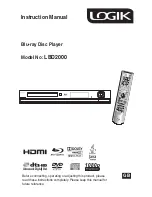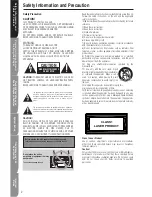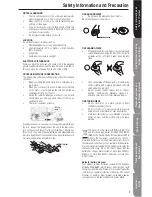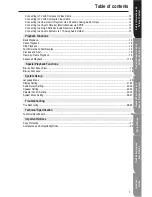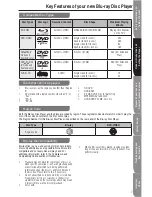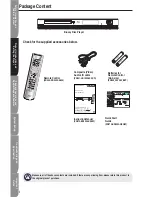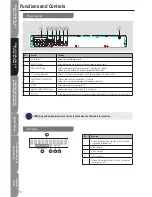
6
S
afe
ty
In
fo
rm
ati
on
a
nd
Ta
ble
o
f C
on
te
nt
P
ro
du
ct
In
tro
du
cti
on
a
nd
S
ett
in
g t
he
P
la
ye
r
P
la
yb
ac
k F
un
cti
on
s a
nd
S
pe
cia
l P
la
yb
ac
k F
ea
tu
re
s
S
ys
te
m
S
et-
up
Tr
ou
ble
sh
oo
tin
g a
nd
S
pe
cif
ic
ati
on
Im
po
rta
nt
N
ot
ic
e
Key Features of your new Blu-ray Disc Player
Player Features
Support a Variety of Video Disc Types
Support Blu-ray (BD-ROM), DVD Video, and DVD
±RW, DVD±R/ DL (V mode and finalised only)
discs.
HDMI (High Definition Multimedia Interface)
HDMI reduces pictures noise by allowing a pure
digital video/ audio signal path from the player to
your TV.
HDMI, High Definition Multimedia Interface supports
EDID and DDC2B. This connection operates quickly
and conveniently, providing the best in both audio
and video playback.
HDMI can transfer incompressed, high-resolution
picture and multichannel audio digitally up to speeds
of 5GBps. HDMI can support all ATSC HDTV
standards not only meet resolution 1080p, which can
supply the highest picture quality, but it also support
DVD Audio and other most advanced digital audio
format, including 8 channel 96kHz digital audio
transmission. You only need one HDMI line
connected, and disconnected the other audio
connection. At the same time, the spare space
which HDMI standard supplied can apply in the
video updating. HDMI can allocate with HDCP
(High-bandwidth Digital Content Protection), avoid
copyright film being copied without authorization.
Blue-ray Disc Features
Blu-ray Discs can store 25GB (single layer) or 50GB
(dual layer) on a single sided disc - about 5 to 10
times the capacity of a DVD. Blu-ray Discs also
support the highest quality HD video available in the
industry - Large capacity means no compromise on
video quality. Furthermore, a Blu-ray Disc has the
same familiar size and look as a DVD.
*The following Blu-ray Disc features are disc
dependant and will vary.
Appearance and navigation of features will also vary
from disc to disc.
Not all discs will have the features described below.
Video highlights
The BD-ROM format supports three highly advanced
vide codecs, including AVC, VC-1, and MPEG-2.
HD video resolutions are also available:
1920 x 1080 High Definition
1280 x 720 High Definition
For High-Definition Playback
To view high-definition contents on a Blu-ray Disc,
an HDTV (High Definition Television) is required.
Some Blu-ray Discs may require using the player’s
HDMI OUT to view high-definition content. The
ability to view high-definition content on Blu-ray
Discs may be limited depending on the resolution of
your TV.
•
•
Graphic Planes
Two individual, full HD resolution (1920x1080) video
layers are available, on top of the HD video layer. One
layer is assigned to video-related graphics (like
subtitles), and the other layer is assigned to interactive
elements, such as buttons or menus. Various wipes,
fades and scroll effects may be available on both layer.
Menu graphics
Support full colour resolution graphics and animation,
thereby greatly surpassing the capabilities of DVD-
Video. Unlike DVD, menus can be accessed during
video playback.
Menu sounds
When you highlight or select a menu option on a disc,
sounds can be heard such as button clicks or a voice-
over explaining the highlighted menu choice.
Multi-page/ PopUp Menus
Unlike the DVD-Video, playback is not interrupted each
time a new menu screen is accessed Due to Blu-ray
Disc’s ability to preload data from the disc without
interrupting playback, a menu may consist of several
pages. You can browse through the menu pages or
select different menu paths, while the audio and video
continues playing in the background.
Interactivity
Certain Blu-ray Discs may contain Animated menus and
Trivia games.
User Browsable Slideshows
With Blu-ray Discs, you can browse through various still
pictures while the audio remains playing.
Subtitles
Depending on what is contained on the Blu-ray Disc, you
may be able to select different font styles, sizes, and
colours for the subtitles. Subtitles may also be animated,
scrolled or faded in and out.
Blu-ray Disc Features (cont')
Structure of Disc Contents
Normally, DVD discs are divided into titles, and the titles
are subdivided into chapters. Audio CD are divided into
tracks.
Each title, chapter, or track is assigned a number, which
is called title number, chapter number, or track number
respectively.
There may be discs that do not have these number.

